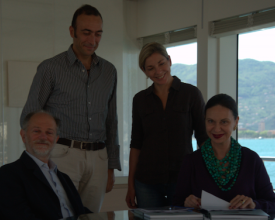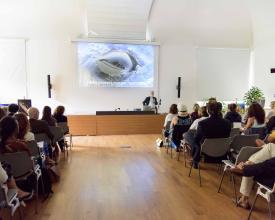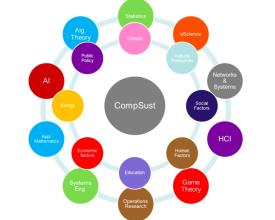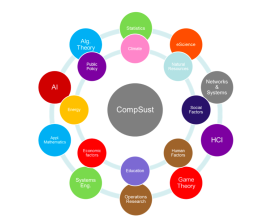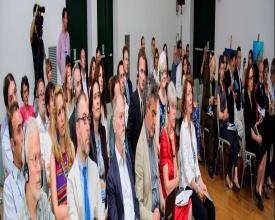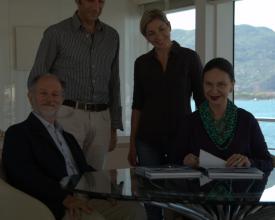
Waterevolution: an integrated approach to maritime cluster sustainability
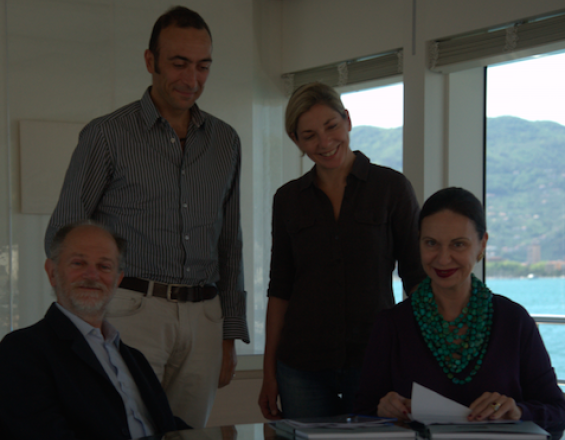
The Waterevolution model develops strategic partnerships between maritime cluster companies and marine conservation. It is based on computational sustainability and allows a substantial reduction of the environmental and energy footprint of the industry through an optimization of the production process. The implementation of this model translates also into significant cost savings, a part of which is reinvested into marine conservation programs, e.g. marine protected area planning and financing.
Context
Challenges addressed
Implementing innovative partnerships, conservation financing, reducing industry footprint Historically, the shipbuilding industry has suffered from the absence of global rules, thus delaying the confrontation of the sector with environmental challenges, but yachting operations have a large environmental footprint. Funding for marine conservation is insufficient; e.g. the Pelagos Sanctuary (largest MPA in the Mediterranean) does not receive enough funding to ensure its effective management
Beneficiaries
- Marine conservation organisations
- Maritime cluster industries
- Local communities
Location
Process
Summary of the process
Waterevolution is a comprehensive, evidence-based model that involves a sustainable corporate management approach to reduce environmental footprint, which generates structural funding to support marine science and conservation projects and facilitates industry commitment to ocean responsibility. The model was developed by Eulabor Institute in partnership with the University of Bologna and was then tested within the Italian super yacht shipyard VSY. The production process of VSY was optimised through the implementation of the computational sustainability tool. The optimisation process translated into a significant reduction of the environmental footprint of the shipyard and, at the same time, was able to generate financial savings. A percentage of these saving were invested to support marine conservation projects by several organisations including: the Tethys Research Institute research on the Pelagos Sanctuary; the IUCN WCPA-Marine Marine Mammal Task Force strategic planning work on the Important Marine Mammal Areas (IMMAs); as well as several marine conservation and awareness activities, communication campaigns for ocean sustainability and a capacity building initiative for Italian MPAs.
Building Blocks
Computational Sustainability
Computational Sustainability is an interdisciplinary tool that integrates techniques from computer science, information science, operations research, applied mathematics, and statistics to serve the purpose of balancing environmental, economic, and societal needs for sustainable development. This tool applies a cradle to cradle approach to production chains and products, by extending the system to the assessment of the whole ship life cycle (construction, shipping, dismantling), and allowing a substantial reduction of the environmental and energy footprint for a particular company by taking into account its financial cost, energy and environmental impact. Computational sustainability allows the company to break down every stage of the production process - the entire life cycle of a product up to the recycling - and evaluates the sustainability elements at each stage by measuring the cost benefit indicators including: - Support yacht designers with mathematical modelling to define, compare and assess alternative solutions along all steps of the yacht design and production - Assess material accounting and a number of environmental indicators along the process
Enabling factors
- Willingness of companies to recondition their core business to embrace energy and resource efficiency
- Favouring economic and technological models that allow optimization of industrial processes, while at the same time reducing environmental impact
- Adoption of a multidisciplinary and holistic approach and implementation of a cradle to cradle perspective embracing the whole ship life cycle (construction, shipping, dismantling)
Lesson learned
Support yacht designers to define, compare and assess alternative solutions and yacht concepts, guide them along all steps of the yacht design proposing alternatives and assess material and activities accounting and a number of environmental indicators along the process. Develop mathematical modelling that provides a scientific support for measuring, defining and comparing alternative processes and use matrix models linking activities with environmental impacts and matrix models linking activities with costs/economic benefits. Along the process the model has also to account for energy consumption, water consumption, CO2 emissions, and raw material used
Cross-sectoral platform for marine conservation
To enable a real commitment to ocean responsibility, a marine strategic agreement between industries and conservation was set up, including a shared platform to facilitate discussion and build awareness about ocean issues while highlighting solutions achievable through collective effort. The establishment of this platform was made possible through multiple events during to facilitate dialogues between different stakeholders from conservation, industries and political institution. The main issue that was highlighted during these events was the fact that bold and transformative steps are urgently needed to shift the world onto a sustainable and resilient path and these steps are only achievable through meaningful collaboration to make informed and coordinated decisions for the future of the ocean and consequently for our own future. Moreover, the increased global awareness about climate change and environmental issues represents a great opportunity for the industry to be proactive in embracing sustainable practices, rather than be enforced to adopt them in the near future, while directly reinvesting in marine conservation.
Enabling factors
- Development of a specific cross-sectoral communication platform to allow for understanding of the model from parties with different backgrounds and interest
- Adoption of a collaborative approach
- Increased awareness of climate change and environmental issues, globally and on the part of the yachting industry
Lesson learned
To actively engage and collectively act, towards societally, environmentally, political and economically sustainable approaches and solutions to tackle ocean challenges, Waterevolution has developed a specific cross-sectoral communication platform that laid the foundations of a strategic alliance. The key lesson learned in implementing this component is related to the difficulty to build partnerships and promote interaction between two completely different sectors. To overcome this challenge, a great investment of time and efforts was made to create interactions opportunities and a clear commitment from both parties to work together to achieve sustainable ocean management. To actively engage and collectively act, towards societally, environmentally, political and economically sustainable approaches and solutions to tackle ocean challenges, Waterevolution has also developed a specific cross-sectoral communication to target information according to the specific audience.
Structured long-term financing for marine conservation
The implementation of the Waterevolution model not only increases resources and energy efficiency within industries but also translates into significant cost savings and consequently increases competitiveness. We pioneered an operational framework to apply and improve environmental standards and transparency in supply chains that affect the oceans and facilitated investment in marine conservation. A key component of the application of this model is that marine industry cluster partners embrace stewardship of the marine environment by reinvesting a percentage of savings into meaningful marine conservation programs proven for their efficiency.Thanks to the pilot project, the following projects were financially supported: - Funded the Tethys Research Institute to update research on the Pelagos Sanctuary, largest marine protected area in the Mediterranean Sea, covering about 90.000 km2 - Funded an entire year of research and strategic planning of the IUCN WCPA-Marine Marine Mammal Task Force’s work on Important Marine Mammals Areas (IMMAs) - On-the-ground marine conservation and awareness activities and communication campaigns for ocean sustainability and conservation including various conferences held in Milan for the Universal EXPO
Enabling factors
- The current need to redefine marine policies dictated by international directives that endeavor to embrace sustainability
- Lack of financial resources to plan and implement long term marine conservation - Adoption of a collaborative approach
- Identification of the natural environment as a key stakeholder and environmental cost as company ‘externalities’
Lesson learned
The main success factor of the model is related to its ability to demonstrate that cost efficiency, sustainable practices and environmental conservation can indeed coexist. The model proposes an innovative operational framework that addresses real ocean responsibility and not just a token payment that is more like charity and not tied to actionable improvement in sustainability. This represent a core challenge for the industry to not just “pose” as friends of the environment (greenwashing) but to significantly recondition their business to decrease their environmental footprint and decide to invest and genuinely commit to ocean sustainability. On the other side the challenge was to find a non profit organisation that was able to provide a strategic project for investment. We found that required criteria were met by the Tethys Research Institute project to update research on the Pelagos Sanctuary and by the IUCN WCPA-Marine Marine Mammal Task Force’s strategic planning work on IMMas
Resources
Impacts
The implementation of the Waterevolution model translated into a significant reduction of the environmental footprint of the shipyard including reduction by 20% of energy consumption and CO2 emissions - this reduction rises up to 30% when dismantling (removal of toxic and hazardous materials) and recycling are considered. Substantial reduction of water pollution and seabed degradation and at least a 10% costs reduction thanks to the process optimisation. Consequent reinvestment into long-term marine conservation projects including the Tethys Research Institute’s research on the Pelagos Sanctuary, the IUCN WCPA-Marine Marine Mammal Task Force strategic planning work on the Important Marine Mammal Areas (IMMAs) and several community-based marine conservation initiatives, conferences, awareness activities and communication campaigns for ocean sustainability and a capacity building initiative for Italian MPAs.
Story
The Waterevolution solution represents a practical example that nature conservation and human progress are not mutually exclusive. It is a credible and accessible technological model, based on Computational Sustainability, that can promote general welfare in ways that support and even enhance our planet’s natural assets. The model links together industry-focused and scientific-based computational sustainability with marine conservation and is able to provide a win-win situation. It allows a substantial reduction of the environmental and energy footprint of the industry through an optimisation of the production process that is able to generate significant cost savings, a part of which is reinvested into marine conservation programs In the pilot project the savings were reinvested into various marine conservation projects including the strategic planning of the IUCN Joint SSC-WCPA Marine Mammal Protected Areas Task Force (started in February 2015) to develop Important Marine Mammal Areas (IMMAs). Thanks to this financial support, the Criteria for IMMA identification (currently undergoing public scrutiny) were drafted and broad consensus and full support on IMMAs were gained within the relevant IUCN Commissions and Sub-Committees. The funding allowed participation of the two main researchers as experts to EBSA Workshops organised by the Secretariat of the Convention on Biological Diversity (Sri Lanka and Dubai), and the provision of information on IMMA development to potential institutional partners such as the French Marine Protected Areas Agency, Pew Charitable Trusts, UNEP’s World Conservation Monitoring Centre, Secretariat of the Convention on Migratory Species, and Secretariat of the Pacific Regional Environment Programme, particularly in view of a possible joint organisation of the South Pacific region Year of the Whale 2016. The Waterevolution model has the potential to not only drive changes into the super yacht business, where the pilot project was implemented, but also within the entire yachting sector and the maritime cluster as a whole while generating structural funding opportunities for marine conservation initiatives worldwide.
